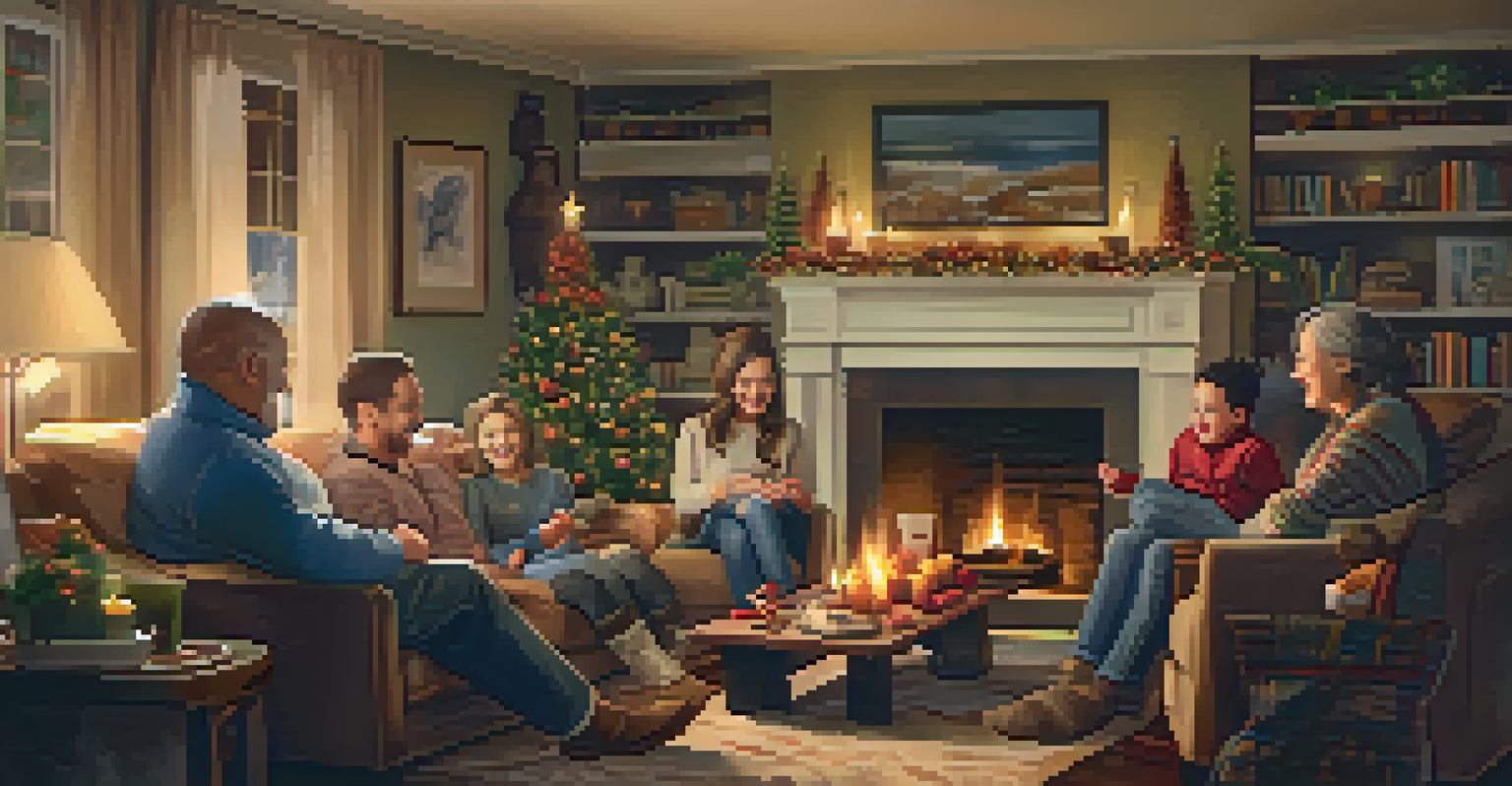Exploring Seasonal Affective Disorder in Different Age Groups

What is Seasonal Affective Disorder (SAD)?
Seasonal Affective Disorder, commonly known as SAD, is a type of depression that occurs at a specific time of year, typically in the fall and winter months. The lack of sunlight during these seasons can disrupt our biological clock, leading to changes in mood and behavior. Symptoms often include feelings of hopelessness, fatigue, and a general lack of interest in activities once enjoyed.
The greatest glory in living lies not in never falling, but in rising every time we fall.
This condition is thought to be linked to changes in daylight exposure, which can affect serotonin levels in the brain, a key hormone that regulates mood. The struggle with SAD can make the colder months feel particularly heavy for those affected. Understanding SAD is crucial, especially as we consider how it manifests differently across various age groups.
Recognizing the signs and symptoms of SAD is the first step toward seeking help. Whether through light therapy, medication, or lifestyle changes, there are effective strategies to combat its effects. Awareness is key to managing this condition and supporting those who experience it.
SAD in Children and Adolescents
Children and adolescents can also experience Seasonal Affective Disorder, though it may present differently than in adults. Young people might show symptoms like irritability, changes in sleep patterns, or a drop in academic performance rather than the classic signs of depression. This can make it harder for parents and teachers to recognize the issue.

For kids, the impact of reduced daylight can be profound. Their social activities, outdoor play, and even sports can diminish, leaving them feeling isolated and moody. Schools and families play a crucial role in monitoring these changes and providing support, which is essential for their emotional well-being.
SAD Affects All Age Groups
Seasonal Affective Disorder impacts individuals differently across various age groups, from children to seniors.
Parents should encourage open conversations about feelings and seasonal changes. Providing opportunities for indoor activities, exposure to bright light, and ensuring a balanced routine can help mitigate the effects of SAD. Early intervention can lead to healthier coping strategies as they grow.
SAD in Young Adults
Young adults often face unique challenges associated with Seasonal Affective Disorder, particularly during transitional life stages such as college or entering the workforce. The stress of new responsibilities, combined with reduced sunlight, can exacerbate feelings of anxiety and depression. This age group may be more vulnerable due to lifestyle changes that disrupt their routines.
It's not the load that breaks you down, it's the way you carry it.
Social media and peer comparisons can amplify feelings of loneliness during the winter months, making it essential for young adults to find healthy outlets for their emotions. Engaging in social activities, even if they're virtual, can help combat feelings of isolation. Moreover, developing a supportive network can provide necessary encouragement during tough times.
Encouraging regular exercise, maintaining a balanced diet, and pursuing hobbies can make a significant difference in managing SAD. Seeking professional help or joining support groups can also provide a sense of connection and understanding. It's about finding what works and taking proactive steps to foster mental health.
SAD in Middle-Aged Adults
Middle-aged adults may experience Seasonal Affective Disorder differently, often feeling overwhelmed by work and family responsibilities. The demands of this stage of life can lead to increased stress, which may compound the effects of seasonal depression. Juggling multiple roles can leave little time for self-care, making it harder to recognize the signs of SAD.
Many middle-aged individuals may also face significant life changes, such as children leaving home or career shifts, which can contribute to feelings of sadness during the winter months. It's essential for this demographic to prioritize mental health and seek support when needed. Establishing routines that incorporate physical activity and social interaction can be particularly beneficial.
Effective Coping Strategies Exist
Light therapy, physical activity, and social connections are valuable strategies for managing SAD symptoms.
Support from loved ones can make a world of difference in managing SAD at this stage. Encouraging open discussions about mental health within families can help normalize the conversation around depression. Taking proactive steps, such as scheduling regular check-ins with friends and family, can create a strong support system.
SAD in Seniors
Seniors are not exempt from Seasonal Affective Disorder, and in fact, they may face additional challenges that exacerbate their symptoms. Factors such as social isolation, health issues, and medication side effects can contribute to feelings of sadness during the winter months. The transition to less sunlight can feel particularly stark for older adults who may already struggle with loneliness.
It's important for caregivers and family members to recognize the signs of SAD in seniors. Encouraging regular social activities, whether in-person or virtual, can help combat feelings of isolation. Simple actions like visiting, playing games, or participating in community programs can significantly uplift their spirits during the darker months.
Additionally, ensuring seniors have access to natural light, whether through sunrooms or light therapy lamps, can aid in managing symptoms. Regular check-ins and open conversations about feelings can foster a supportive environment. Empathy and understanding are crucial for helping seniors navigate the challenges of SAD.
Coping Strategies for All Ages
Regardless of age, there are effective coping strategies that can help manage Seasonal Affective Disorder. Light therapy has become a popular option, where individuals sit near a light box that mimics natural sunlight. This can help regulate sleep patterns and improve mood, making it a valuable tool for many experiencing SAD.
Incorporating regular physical activity into daily routines is another excellent way to combat SAD. Exercise releases endorphins, which can enhance mood and provide a sense of accomplishment. From brisk walks to yoga classes, staying active can be a vital component of managing symptoms across all age groups.
Seek Help When Needed
Recognizing when SAD significantly disrupts daily life is crucial, and consulting a mental health professional can provide essential support.
Additionally, fostering connections with others, whether through social gatherings or online communities, can provide emotional support. Engaging in hobbies, practicing mindfulness, and maintaining a balanced diet are also key strategies. It's about finding what resonates and creating a personalized approach to tackling Seasonal Affective Disorder.
When to Seek Professional Help
While coping strategies can be effective, there are times when seeking professional help becomes essential. If symptoms of Seasonal Affective Disorder significantly impact daily life, such as hindering work performance or disrupting social relationships, it’s crucial to consult a mental health professional. Therapy and medication can provide the necessary support for managing severe cases.
Recognizing when to seek help can be challenging, especially when symptoms may feel like a normal part of winter blues. If feelings of hopelessness, prolonged sadness, or changes in appetite and sleep persist, it’s important to reach out. Mental health professionals can offer tailored strategies that address individual needs, making a significant difference in managing SAD.

Support networks, including family and friends, can encourage individuals to seek help when necessary. Normalizing conversations around mental health can empower those struggling to take the next step. Remember, reaching out for help is a sign of strength, and there are resources available to ensure better mental health.
Final Thoughts on SAD and Age Diversity
Understanding how Seasonal Affective Disorder affects different age groups is crucial for fostering empathy and support. Each age group experiences SAD uniquely, influenced by various life stages and responsibilities. By recognizing these differences, we can create more inclusive conversations around mental health and seasonal changes.
Encouraging open discussions about SAD allows individuals to share their experiences and coping strategies, contributing to a sense of community. It’s important to remember that no one is alone in their struggles, and support is available for everyone. From children to seniors, everyone can benefit from understanding and shared experiences.
As we approach the darker months, let’s prioritize mental health and support one another. Whether through seeking professional help, engaging in community activities, or simply checking in with loved ones, there are many ways to combat the effects of SAD. Together, we can navigate these challenges and promote a healthier, happier winter season.